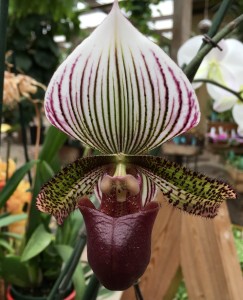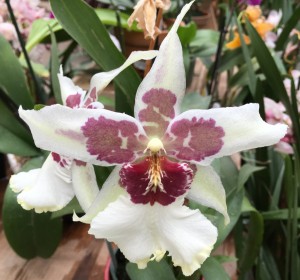Hello fellow readers,
I love questions on things I wish to learn more about. Gloria of Columbia NJ, has enjoyed her Lady Slipper orchid for 23 years. She divided it recently and the twins are now beginning their bloom cycle. However, some of the leaves are turning yellow and Gloria is concerned if she’s overwatering.
Orchids originate from the days of the dinosaurs. Their delicate somewhat prissy appearance suggest they are fussy to take care of. In truth, many are easy keepers. Lady slipper orchids are one of the simplest orchids to grow. Other easy keepers are the Cattleya group with medium to large brightly colored flowers and Moth orchids that produce sprays of glorious blooms.
Watering is one of the trickier yet most important cultural practices. Allow the potting mix to dry out completely before watering, then water until it runs out the bottom of the pot. No sitting in water though. Humidity trays or gravel on top of saucers can catch the excess and help maintain the preferred 50% humidity.
It’s from the new growth that new blooms come, so Gloria’s orchids sound healthy. The yellowing leaves are likely the normal shedding of old leaves. You can let the them die back naturally or cut them off with a clean utensil to prevent disease. If the yellowing leaves have dark slimy spots, its cause for concern that there’s a fungus among us or a bacteria.
Orchids at shows or public gardens such as Longwood Gardens in Kennett Square, PA or the New York Botanical Gardens in Bronx NY remind me of fine art on display at a museum. It’s the time of year to indulge in orchid shows as their peak bloom times are typically winter to late spring.
In their native environments orchids are often seen growing on trees. They’re not parasites though, they’re merely using the trees as hosts. They have very cool reproductive ‘systems’ too; beyond the normal lures of color and fragrance. For example, the Bee Orchid (Ophrys insectifera) have flowers that mimic a receptive female bee tricking the male bee to come hither (whoops we’re G-rated).
Lady’s slipper orchids attract pollinators with their scented flowers that have slippery edges leading to pouches that forces the insect in. The pollinator becomes too wet to fly out or the space is too tight; forcing Mr. Unsuspecting to exit in such a way that triggers pollination. How stealth!
Garden dilemmas? askmarystone@gmail.com
The American Orchid Society offers an article Orchids 101 that offers up the basics of growing orchids.
About the photos: I had the privilege of visiting Meadowbrook Farms located just north of Philadelphia in Abington Township where I took these photos. Affiliated with the Pennsylvania Horticultural Society, Meadowbrook Farms is known for their part in forcing flowers and plants to bloom in time for the Philadelphia Flower Show each year. My colleague and friend, Marty Carson of Three Seasons, also uses Meadowbrook to propagate her plants for the Springfest Garden Show coming soon: March 17 through 20th, 2016. See you at the show!





